smc Pentax-D FA 100mm F/2.8 Macro WR
Macro lens • Digital era • Discontinued
Abbreviations
| SMC | Multi-layer anti-reflection coating is applied to the surfaces of lens elements. This anti-reflection coating increases light transmission, eliminates flare and ghosting, and maintains color consistence among all lens models. |
| D FA | Autofocus lens which is optimized for Pentax digital SLR cameras but can be also used on Pentax film SLR cameras. Learn more |
| MACRO | Macro lens. Designed specially for shooting close-ups of small subjects but can be also used in other genres of photography, not necessarily requiring focusing at close distances. Learn more |
| WR | Water-Resistant lens. |
Model history (6)
| ■smc Pentax-A 100mm F/2.8 Macro • 1:1 | A | 7 - 7 | 0.31m | ⌀58 | 1985 ● | |
| ■smc Pentax-F 100mm F/2.8 Macro • 1:1 | A | 9 - 8 | 0.31m | ⌀58 | 1987 ● | |
| ■smc Pentax-FA 100mm F/2.8 Macro • 1:1 | A | 9 - 8 | 0.31m | ⌀58 | 1991 ● | |
| ■smc Pentax-D FA 100mm F/2.8 Macro • 1:1 aka Schneider-Kreuznach D-Xenon 100mm F/2.8 Macro | A | 9 - 8 | 0.30m | ⌀49 | 2004 ● | |
| ■smc Pentax-D FA 100mm F/2.8 Macro WR • 1:1 | A | 9 - 8 | 0.30m | ⌀49 | 2009 ● | |
| ■HD Pentax-D FA 100mm F/2.8 ED AW Macro • 1:1 | A | 10 - 8 | 0.30m | ⌀49 | 2022 ● | |
| HD Pentax-D FA 100mm F/2.8 ED AW Macro Silver (300 units) • 1:1 | 2022 ● | |||||
Features highlight





Specification
| Production details: | |
| Announced: | December 2009 |
| Production status: | ● Discontinued |
| Original name: | SMC PENTAX-DFA MACRO 1:2.8 100mm WR |
| System: | Pentax K (1975) |
| Optical design: | |
| Focal length: | 100mm |
| Speed: | F/2.8 |
| Maximum format: | 35mm full frame |
| Mount and Flange focal distance: | Pentax K [45.5mm] |
| Diagonal angle of view: | 24.4° |
| Lens construction: | 9 elements in 8 groups |
| Floating element system | |
| On Pentax K APS-C [1.53x] cameras: | |
| 35mm equivalent focal length: | 153mm (in terms of field of view) |
| 35mm equivalent speed: | F/4.3 (in terms of depth of field) |
| Diagonal angle of view: | 16.1° |
| Diaphragm mechanism: | |
| Diaphragm type: | Automatic |
| Aperture control: | None; the aperture is controlled from the camera |
| Number of blades: | 8 (eight) |
| Focusing: | |
| Closest focusing distance: | 0.303m |
| Closest working distance: | 0.13m |
| Magnification ratio: | 1:1 (life-size) |
| Focusing modes: | Autofocus, manual focus |
| Autofocus motor: | In-camera motor |
| Manual focus control: | Focusing ring |
| Focus mode selector: | None; focusing mode is set from the camera |
| Quick-Shift Focus System (QFS): | Yes |
| Shake Reduction (SR): | |
| Built-in SR: | - |
| Physical characteristics: | |
| Weight: | 340g |
| Maximum diameter x Length: | ⌀65×80.5mm |
| Weather sealing: | Water-resistant barrel |
| Super Protect (SP) coating: | Yes |
| Accessories: | |
| Filters: | Screw-type 49mm |
| Lens hood: | PH-RBE49 - Bayonet-type round |
| Teleconverters: | HD Pentax-DA 1.4X AF Rear Converter AW → 140mm F/3.9 |
| Source of data: | |
| Manufacturer's technical data. | |
Compared to the smc Pentax-D FA 100mm F/2.8 Macro
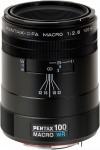
- Advantages: 2
- Disadvantages: 0
Manufacturer description #1
GOLDEN, COLORADO (December 9, 2009)…PENTAX Imaging Company has announced the smc PENTAX D FA MACRO 100mm F2.8 WR lens designed for use with PENTAX digital SLR cameras. Combining a high-quality exterior finish with PENTAX-original weather-resistant construction, this new macro lens is especially useful for the demands of outdoor photography.
This PENTAX macro lens features a high-grade, aluminum barrel with the high-quality, exclusive exterior design and finish unique to the PENTAX D FA series lenses. Further, the entire mechanism of the focus ring has been reviewed and upgraded to assure flawless manual-focus operation. For improved performance, the PENTAX D FA MACRO 100mm F2.8 WR is the first PENTAX interchangeable macro lens featuring a completely rounded diaphragm blade to create a natural, beautiful bokeh at wide apertures, while minimizing the streaking effect of point light sources.
PENTAX WR lenses feature simplified weather-resistant construction to repel water and moisture. Combined with a PENTAX weather-resistant K-7, K20D, K200D or K10D digital SLR camera body, the lens performs well in damp, inclement outdoor conditions including rain, mist, water spray and splashes.
The lens also features the PENTAX-original SP (Super Protect) surface coating to repel dust, water and grease and to minimize fingerprints.
Other significant features of this latest WR lens include:
- Mounted on a PENTAX digital SLR camera body, this lens offers a focal length equivalent to 153mm in the 35mm format for high-quality, true-to-life images, while minimizing flare and ghost images. The maximum life-size magnification allows photographers to capture dramatic close-up images with great ease.
- A working distance of just over five inches (13 cm) facilitates close-up photography of subjects including flora, insects, and wildlife.
- The PENTAX-developed Quick-Shift Focus System for instant switching to manual-focus operation after the subject is captured in focus by the camera’s AF system.
- An image circle to accommodate 35mm film-format camera image size.
- Compatibility with the macro adapter included in the PENTAX AF160FC dedicated Auto Macro Ring Flash.
Manufacturer description #2
December 10, 2009 - HOYA CORPORATION PENTAX Products is pleased to announce the launch of the smc PENTAX-D FA MACRO 100mmF2.8 WR, an interchangeable macro lens designed for use with PENTAX digital and film-format SLR cameras. Combining a high-quality exterior finish with a PENTAX-original simplified weather-resistant construction, this new macro lens is especially useful for demanding outdoor applications.
Major Features
1. High-quality exterior finish with high-grade aluminum barrel
This macro lens features a high-grade chipped-aluminum barrel, and its exterior design has been greatly refined from that of the existing D FA-series lenses to deliver a more sophisticated, exclusive appearance. The entire mechanism of the focus ring has been reviewed and upgraded to assure flawless manual-focus operation.
2. Simplified weather-resistant construction for greater reliability outdoors
This macro lens features a simplified weather-resistant construction, which minimizes the intrusion of water and moisture into the lens barrel. By mounting the lens on a PENTAX weather-resistant digital SLR camera body, the user is assured of greater durability and reliability when shooting in rain or mist, as well as at locations subject to a spray or splash. The lens also features the PENTAX-original SP (Super Protect) coating on its front surface to repel dust, water and grease and to minimize fingerprints and cosmetic spots. These features make the lens ideal for all types of outdoor applications.
3. Rounded diaphragm blade to produce a beautiful bokeh
The PENTAX-D FA MACRO 100mmF2.8 WR is the first PENTAX interchangeable macro lens featuring a completely rounded diaphragm blade. This creates a natural, beautiful bokeh, while minimizing the streaking effect of point light sources.
4. High-quality image description
When mounted on a PENTAX digital SLR camera body, this lens offers a focal length equivalent to 153mm in the 35mm format. Inheriting the high-performance optics of the renowned smc PENTAX-D FA MACRO 100mmF2.8 lens, it delivers high-quality, true-to-life images, while minimizing annoying flare and ghost images — problems common in digital SLR photography. Its maximum magnification of life size allows the photographer to capture dramatic close-up images with great ease.
5. Other features
- A working distance of 13cm (in life-size applications) to facilitate the shooting of unapproachable subjects, such as insects
- The PENTAX-developed Quick-Shift Focus System for instant switching to manual-focus operation after the subject is captured in focus by the camera’s AF system
- An image circle accommodating the image size of 35mm film-format cameras
- Compatibility with the macro adapter included in the PENTAX AF160FC Dedicated Auto Macro Flash
Manufacturer description #3
This telephoto lens with ultra-close focusing capabilities is a multi-talented player, delivering clear, high-contrast images from both telephoto and macro perspectives. It is ideal for the close- up photographer looking for full-size subject magnification and outstanding depth of field control for the smallest of subjects. This lens has the same outstanding characteristics as its 50mm sister model, and has managed to minimize the weight and size when compared to other macro lenses. This lens also produces a 1:1 magnification ratio and features the unique PENTAX FREE technology; ensuring exceptional focusing distance to infinity by effectively reducing annoying aberrations at any focusing distance.
With 150mm focal length in the 35mm format, the photographer enjoys the comfort and safety of a greater working distance to the subject, making it ideal for photographing insects, for example. The D FA 100mm has, like its sister model, a switch that locks the focus setting, making it impossible to inadvertently change the focus while concentrating on getting the perfect shot. This lens is equipped with protective seals and is resistant to humidity
Manufacturer description #4
High-quality macro lens using simple drip-proof construction. This lens enables 1:1 (1X) photography at distances up to 13cm from the lens to the subject. The refined aluminum alloy body has a simple drip-proof construction and is built with a compact, lightweight design without an iris ring. This reduces ghosting and flare for enabling superior imaging performance for sharp images with high contrast at all shooting distances. A round iris diaphragm is used for rendering natural out-of-focus (bokeh) background effect.
New sleek machined aluminum outer casing is used for a refined lens appearance. *The focus mechanism has been completely revised for enabling smooth focusing when using the manual focus and a comfortable sense of operation.
This lens uses a simple drip-proof construction for preventing water from getting inside the lens. Combined with PENTAX digital SLR cameras also using a drip-proof construction enables use in rainy or foggy conditions, or other locations exposed to water for enhanced durability and reliability.
This lens has a focal length equivalent to 153mm in the 35mm film format.
The FREE (fixed rear element extension) focusing system is used to minimize ghosting and flare and provide clear, high-quality images from the infinity end to macro distances. Closeups up to a maximum of 1:1 (1X) are possible. The working distance is longer than the macro of 50mm for enabling effective shooting of subjects that are difficult to approach.
A new round iris diaphragm is used from open to F5.6. This reduces the beams of light when shooting point light sources for enabling a more natural out-of-focus (bokeh) effect.
A SP (super protect) coating is used on the front lens for repelling water and oils to enable shooting with peace of mind even in outdoor environments.
If you turn the focus ring after focusing by the AF, focusing instantly switches to the manual focus. This enables smooth focusing operations without the need for a switching operation.
Pentax-D FA series
The fifth generation of autofocus lenses designed for Pentax digital SLR cameras, but compatible with Pentax 35mm film SLR cameras. Introduced after the Pentax *ist D in 2004.
- Lens barrels made from engineering plastic;
- Weather-resistant designs;
- Do not have an aperture ring. The aperture is controlled from the camera;
- Automatic focusing using in-lens motor (except for macro lenses which rely on in-camera motor);
- Quick-Shift Focus System with Pentax digital SLR cameras.
Travellers' choice
- Fast speed (F/2.8)
- Lightweight (340g)
- Water-resistant barrel
- Super Protect (SP) coating
From the editor
Version of the smc Pentax-D FA 100mm F/2.8 Macro lens which has a new chipped-aluminum water-resistant barrel and Super Protect coating, but lacks the aperture ring and CLAMP switch. The overall build quality is so high that the lens actually deserves the Limited designation. The entire mechanism of the focusing ring was reviewed and upgraded. The angle of rotation of the ring is now about 270 degrees which is more than enough to perform very precise manual focusing. Focus limiter is still missing, though.
Compared to other macro lenses in the Pentax K system
- Weather sealed, along with the HD Pentax-D FA 100/2.8 ED AW Macro
Other macro lenses in the Pentax K system
Sorted by focal length and speed, in ascending order
Lenses with similar focal length
Sorted by manufacturer name
Table of contents
Clickable
- 1. Photo
- 2. Abbreviations
- 3. Sample photos
- 4. Model history (6)
- 5. Features highlight
- 6. Specification
- 7. Compared to the smc Pentax-D FA 100mm F/2.8 Macro
- 8. Manufacturer descriptions (4)
- 9. Pentax-D FA series
- 10. Travellers' choice
- 11. From the editor
- 12. Compared to other macro lenses in the Pentax K system
- 13. Other macro lenses in the Pentax K system (9)
- 14. Lenses with similar focal length (9)
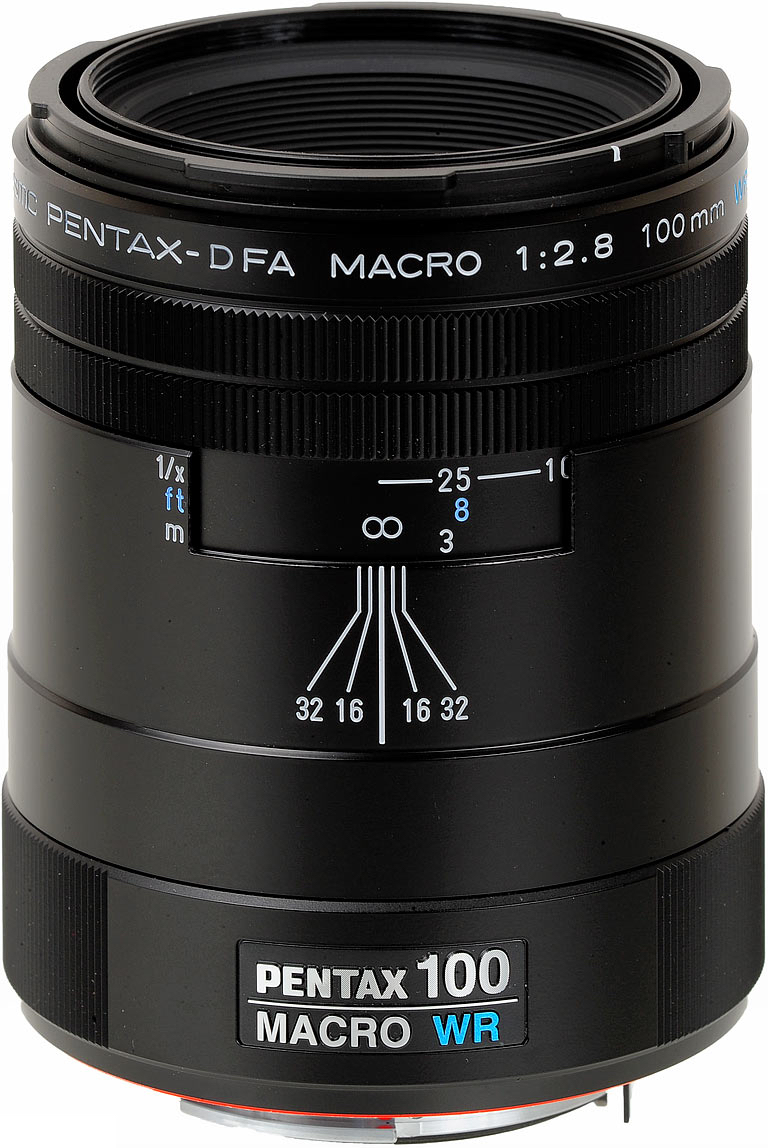


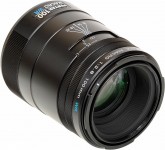

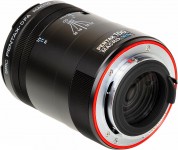

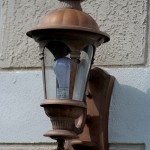






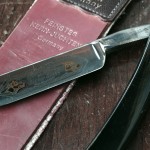
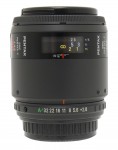

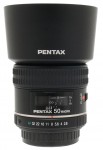



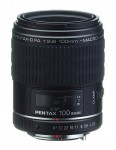
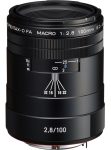
![smc Pentax-FA* 200mm F/4 ED [IF] Macro](https://lens-db.com/wp-content/uploads/2012/07/2004macro-1-91x150.jpg)
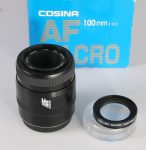

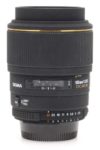


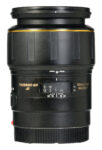


![Tokina AT-X Macro AF 100mm F/2.8 [IF]](https://lens-db.com/wp-content/uploads/2012/09/tokina-m100-01-97x150.jpg)